History of Magadan
Foundation of Magadan
At the beginning of the 20th century, in connection with the search for new places for the extraction of precious metals, the interest of the Russian government in the development of Chukotka and the coast of the Sea of Okhotsk increased. Several expeditions were sent to the eastern outskirts of the Russian Empire, but no significant gold reserves were discovered.
In 1915, Shafigullin, a lone prospector, found the first gold in Kolyma - a historical region in northeastern Russia encompassing the Kolyma River basin and the northern coast of the Sea of Okhotsk. Kolyma includes the entire territory of the Magadan region and the northeastern districts of Yakutia.
In 1926, the expedition of S.V. Obruchev proved favorable geological conditions for the occurrence of gold in this region. In 1928, the First Kolyma Expedition of Yu. A. Bilibin laid the foundation for a detailed study of Kolyma. Reliable information about economic geography of the region was obtained by the hydrographic expedition of I.F. Molodykh, who recommended the Nagaev Bay as a convenient place for the construction of a sea port. Today, the city of Magadan stands on the eastern coast of this bay, and the Magadan commercial sea port can be found on the northern coast.
The settlement of Magadan on the site of the future city was founded in 1929. In November 1931, when the demobilized soldiers of the Far Eastern Army arrived, the population of the settlement increased from 500 to 2,000 people.
More historical facts…
Magadan - the center of a huge forced labor camp
Miners and geologists needed a constant supply of food and equipment. In 1931, the State Trust for Industrial and Road Construction in the Upper Kolyma region “Dalstroy” was created, the initial task of which was the construction of a road from the sea coast to the mining areas.
In order to ensure the existing and planned work of “Dalstroy” in the territories where the permanent population was previously practically absent, the North-East Forced Labor Camp was established. With the opening of navigation of 1932, the mass transportation of convicts began. In 1932-1933, almost all of them (several tens of thousands) died because of severe frosts as they were not provided with winter clothing and insulated housing.
Only the convicts brought to Magadan in 1934 were mostly able to survive the first winter. At this time, large-scale construction of the Kolyma road, river ports, airfields, settlements, and the “capital” of the region, Magadan, began. On July 14, 1939, the settlement of Magadan was transformed into a town. This date is considered to be the year of birth of Magadan.
Construction intensified after the Second World War. At that time, the city center took its current form with buildings along the streets Lenina, Portovaya, Gorky, Pushkina. Japanese prisoners of war also worked on the construction of these buildings.
New waves of prisoners passed through Magadan, mostly Soviet prisoners of war released from German camps. They built roads, new gold mines, as well as buildings in Magadan. Not everyone managed to survive in the harsh conditions of the North and hard labor, a lot of them were rehabilitated posthumously.
Magadan in the second half of the 20th century and beyond
In 1951, the maximum number of convicts working in Kolyma was reached (more than 170 thousand people). Since the 1950s, they were gradually replaced by workers and specialists from other regions of the USSR attracted by economic rather than repressive methods (higher wages and other benefits).
In December 1953, Magadan Oblast was formed on the territory of “Dalstroy” and the city of Magadan became its administrative center. In 1954, regular air traffic began between Magadan and Moscow (the flight on the Il-12 aircraft lasted 48 hours).
In 1963, a new general plan of the city was adopted, which provided for an increase in the building area five times. On the eve of the 25th anniversary of Magadan, its population was more than 70 thousand people.
In 1991, the population of Magadan reached its maximum - about 155 thousand people. Over the next 30 years, it decreased by 40%. The main reasons for leaving the city and the region are the lack of job opportunities and career growth, dissatisfaction with the level of salaries, the lack of opportunities for self-realization, and the desire for changes in life.
Magadan - Features
Magadan is the northernmost of the regional centers of the Russian Far East. It is surrounded by small volcanoes (called “sopka” in the Far East) that rise 150-700 meters above sea level. The Magadanka River divides the city into two parts. The historic center is formed by ensembles of buildings constructed according to the designs of Leningrad architects in the neoclassical style in the 1950s.
The origin of the city’s name is still not known exactly. According to one version, it came from the Even word “mongodan” - marine sediments, according to the other - “mongot” - a dried tree, then “mongodan” - a cluster of dried trees.
The golden deer on the coat of arms of Magadan symbolizes such important sectors of the local economy as gold mining and reindeer husbandry. The blue stripe with stylized sea waves shows that Magadan is the sea gate of Kolyma.
This city is located in an area with harsh climatic conditions. Magadan is characterized by a subarctic climate. Winter is long and cold, softened by the Sea of Okhotsk. Summer is short and cool with frequent winds. June is the period of the so-called “white nights” during which natural lighting remains relatively high. Spring begins only at the end of May and winter returns in October. The average temperature in January is minus 15.6 degrees Celsius, in July - plus 13.4 degrees Celsius.
The development of this territory is associated with mineral resources - gold, silver, tin, hydrocarbons, copper, molybdenum, etc. There are large reserves of coal and brown coal, various building materials, volcanic ash, zeolites, mineral springs. Magadan Oblast is one of the main suppliers of gold and silver in Russia.
There are fish processing enterprises, machine-building plants and other industrial enterprises in the city. The Magadan Mechanical Repair Plant manufactures heavy mining equipment and spare parts for it. In the post-Soviet years, important enterprises of the gold mining industry were opened.
In the early 1930s, the road “Kolyma” was built from Magadan. Today, the length of this federal highway is over two thousand kilometers. It passes through the Kolyma districts where precious metals are mined to the villages of the Republic of Sakha (Yakutia). Magadan is not connected by rail with the rest of Russia.
Magadan has the second largest seaport in the north-east of the Russian Federation (after Petropavlovsk-Kamchatsky). The international airport “Magadan” named after Vladimir Vysotsky, the largest airport in the north-east of Russia, offers regular flights to Moscow, Khabarovsk, Vladivostok, Irkutsk, Yakutsk, Petropavlovsk-Kamchatsky.
In Magadan, there is the North-Eastern Scientific Center of the Far Eastern Branch of the Russian Academy of Sciences, which unites the following academic divisions: the North-Eastern Integrated Research Institute, the Institute for Biological Problems of the North, and the research center “Arctic”. In addition, the Magadan Research Institute of Fisheries and Oceanography is also located here.
Main Attractions of Magadan
Monument “Mask of Sorrow” at the observation deck near Krutaya Sopka - a memorial created by Ernst Neizvestny in memory of the victims of political repression and opened in 1996. Until 1957, more than 2 million convicts were brought to Kolyma and Chukotka, about 120-130 thousand of them died in forced labor camps, about 10 thousand were shot.
This 15-meter concrete sculpture in the style of cubism depicts a giant human head. Inside the monument there is a room where the interior of a prison cell is recreated. The place for the memorial was not chosen by chance, there was a transfer point on this hill, where convicts were gathered to be sent to different camps.
Monument “Time” - a metal sculpture of a mammoth almost 4 meters high. It was installed for the 60th anniversary of Magadan Oblast in 2013. Scrap metal was chosen as a building material from what used to be a bunch of clocks. In just a year, a corrosive film covered the metal and the sculpture acquired the color of the natural wool of a mammoth. Portovoye Shosse Street.
Magadan Regional Museum of Local Lore - one of the largest scientific and educational museums in the north-east of Russia. The museum has archaeological and cartographic collections, historical documents and photographs, a large collection of sculpture and painting, decorative and applied arts, zoological and numismatic collections, household items of the indigenous peoples, as well as more than 14 thousand books and 6 thousand material monuments of history and culture. Karla Marksa Avenue, 55.
Natural History Museum. The expositions of this museum are dedicated to the history, flora, fauna, and natural resources of the north of the Russian Far East. Its collection includes over 4 thousand artifacts, including a unique collection of 15 meteorites. Exhibitions of shamanic ritual accessories, old Chukchi sledges, hunting and fishing tools used by the peoples of the North are of particular interest to visitors, as well as a collection of gems (agates, amethysts, tourmalines, jasper). Portovaya Street, 16.
Geological Museum. Here you can see a unique collection of fossils from the Jurassic period and beautiful gems that the Far Eastern land is rich in. The collection of native gold and silver from the Kolyma deposits is of no less interest. Also, visitors will hear a fascinating story about the history of gold mining in Kolyma. Proletarskaya Street, 11.
Gallery of Contemporary Art. Collective and personal exhibitions of local painters, graphic artists, sculptors, bone carvers, photo artists are held here. In this gallery you can also buy some exhibits. It is located on the second floor of the cultural and sports complex “Metallist”. Pushkina Street, 8.
Holy Trinity Cathedral - the largest Orthodox church in the Russian Far East, one of the tallest churches in Russia (over 70 meters), consecrated in 2011. This cathedral is visible from almost anywhere in the city. The prototype of the architectural solution of the cathedral was the old Russian Vladimir-Novgorod architecture. Sobornaya Square, 1.
Magadan also has a music and drama theater, a puppet theater, and a philharmonic society.


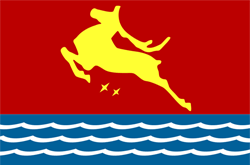
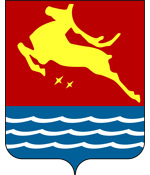
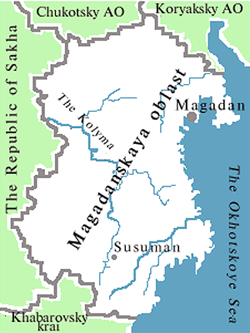
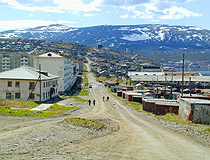
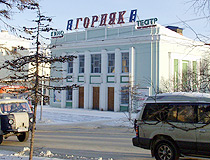
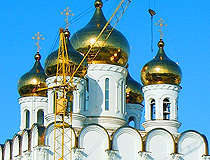
The comments of our visitors